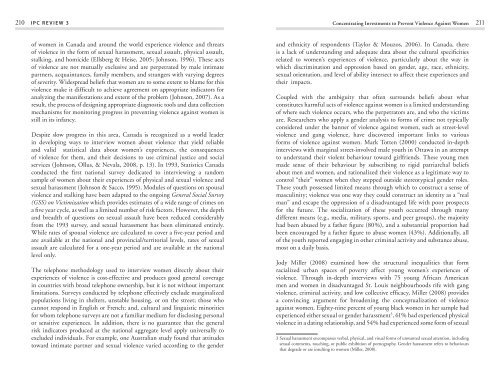Full text - Faculty of Social Sciences - Université d'Ottawa
Full text - Faculty of Social Sciences - Université d'Ottawa
Full text - Faculty of Social Sciences - Université d'Ottawa
You also want an ePaper? Increase the reach of your titles
YUMPU automatically turns print PDFs into web optimized ePapers that Google loves.
210 IPC Review 3 Concentrating Investments to Prevent Violence Against Women 211<br />
<strong>of</strong> women in Canada and around the world experience violence and threats<br />
<strong>of</strong> violence in the form <strong>of</strong> sexual harassment, sexual assault, physical assault,<br />
stalking, and homicide (Ellsberg & Heise, 2005; Johnson, 1996). These acts<br />
<strong>of</strong> violence are not mutually exclusive and are perpetrated by male intimate<br />
partners, acquaintances, family members, and strangers with varying degrees<br />
<strong>of</strong> severity. Widespread beliefs that women are to some extent to blame for this<br />
violence make it difficult to achieve agreement on appropriate indicators for<br />
analyzing the manifestations and extent <strong>of</strong> the problem (Johnson, 2007). As a<br />
result, the process <strong>of</strong> designing appropriate diagnostic tools and data collection<br />
mechanisms for monitoring progress in preventing violence against women is<br />
still in its infancy.<br />
Despite slow progress in this area, Canada is recognized as a world leader<br />
in developing ways to interview women about violence that yield reliable<br />
and valid statistical data about women’s experiences, the consequences<br />
<strong>of</strong> violence for them, and their decisions to use criminal justice and social<br />
services (Johnson, Ollus, & Nevala, 2008, p. 13). In 1993, Statistics Canada<br />
conducted the first national survey dedicated to interviewing a random<br />
sample <strong>of</strong> women about their experiences <strong>of</strong> physical and sexual violence and<br />
sexual harassment (Johnson & Sacco, 1995). Modules <strong>of</strong> questions on spousal<br />
violence and stalking have been adapted to the ongoing General <strong>Social</strong> Survey<br />
(GSS) on Victimization which provides estimates <strong>of</strong> a wide range <strong>of</strong> crimes on<br />
a five year cycle, as well as a limited number <strong>of</strong> risk factors. However, the depth<br />
and breadth <strong>of</strong> questions on sexual assault have been reduced considerably<br />
from the 1993 survey, and sexual harassment has been eliminated entirely.<br />
While rates <strong>of</strong> spousal violence are calculated to cover a five-year period and<br />
are available at the national and provincial/territorial levels, rates <strong>of</strong> sexual<br />
assault are calculated for a one-year period and are available at the national<br />
level only.<br />
The telephone methodology used to interview women directly about their<br />
experiences <strong>of</strong> violence is cost-effective and produces good general coverage<br />
in countries with broad telephone ownership, but it is not without important<br />
limitations. Surveys conducted by telephone effectively exclude marginalized<br />
populations living in shelters, unstable housing, or on the street; those who<br />
cannot respond in English or French; and, cultural and linguistic minorities<br />
for whom telephone surveys are not a familiar medium for disclosing personal<br />
or sensitive experiences. In addition, there is no guarantee that the general<br />
risk indicators produced at the national aggregate level apply universally to<br />
excluded individuals. For example, one Australian study found that attitudes<br />
toward intimate partner and sexual violence varied according to the gender<br />
and ethnicity <strong>of</strong> respondents (Taylor & Mouzos, 2006). In Canada, there<br />
is a lack <strong>of</strong> understanding and adequate data about the cultural specificities<br />
related to women’s experiences <strong>of</strong> violence, particularly about the way in<br />
which discrimination and oppression based on gender, age, race, ethnicity,<br />
sexual orientation, and level <strong>of</strong> ability intersect to affect these experiences and<br />
their impacts.<br />
Coupled with the ambiguity that <strong>of</strong>ten surrounds beliefs about what<br />
constitutes harmful acts <strong>of</strong> violence against women is a limited understanding<br />
<strong>of</strong> where such violence occurs, who the perpetrators are, and who the victims<br />
are. Researchers who apply a gender analysis to forms <strong>of</strong> crime not typically<br />
considered under the banner <strong>of</strong> violence against women, such as street-level<br />
violence and gang violence, have discovered important links to various<br />
forms <strong>of</strong> violence against women. Mark Totten (2000) conducted in-depth<br />
interviews with marginal street-involved male youth in Ottawa in an attempt<br />
to understand their violent behaviour toward girlfriends. These young men<br />
made sense <strong>of</strong> their behaviour by subscribing to rigid patriarchal beliefs<br />
about men and women, and rationalized their violence as a legitimate way to<br />
control “their” women when they stepped outside stereotypical gender roles.<br />
These youth possessed limited means through which to construct a sense <strong>of</strong><br />
masculinity; violence was one way they could construct an identity as a “real<br />
man” and escape the oppression <strong>of</strong> a disadvantaged life with poor prospects<br />
for the future. The socialization <strong>of</strong> these youth occurred through many<br />
different means (e.g., media, military, sports, and peer groups), the majority<br />
had been abused by a father figure (80%), and a substantial proportion had<br />
been encouraged by a father figure to abuse women (43%). Additionally, all<br />
<strong>of</strong> the youth reported engaging in other criminal activity and substance abuse,<br />
most on a daily basis.<br />
Jody Miller (2008) examined how the structural inequalities that form<br />
racialized urban spaces <strong>of</strong> poverty affect young women’s experiences <strong>of</strong><br />
violence. Through in-depth interviews with 75 young African American<br />
men and women in disadvantaged St. Louis neighbourhoods rife with gang<br />
violence, criminal activity, and low collective efficacy, Miller (2008) provides<br />
a convincing argument for broadening the conceptualization <strong>of</strong> violence<br />
against women. Eighty-nine percent <strong>of</strong> young black women in her sample had<br />
experienced either sexual or gender harassment 3 , 61% had experienced physical<br />
violence in a dating relationship, and 54% had experienced some form <strong>of</strong> sexual<br />
3 Sexual harassment encompasses verbal, physical, and visual forms <strong>of</strong> unwanted sexual attention, including<br />
sexual comments, touching, or public exhibition <strong>of</strong> pornography. Gender harassment refers to behaviours<br />
that degrade or are insulting to women (Miller, 2008).
















